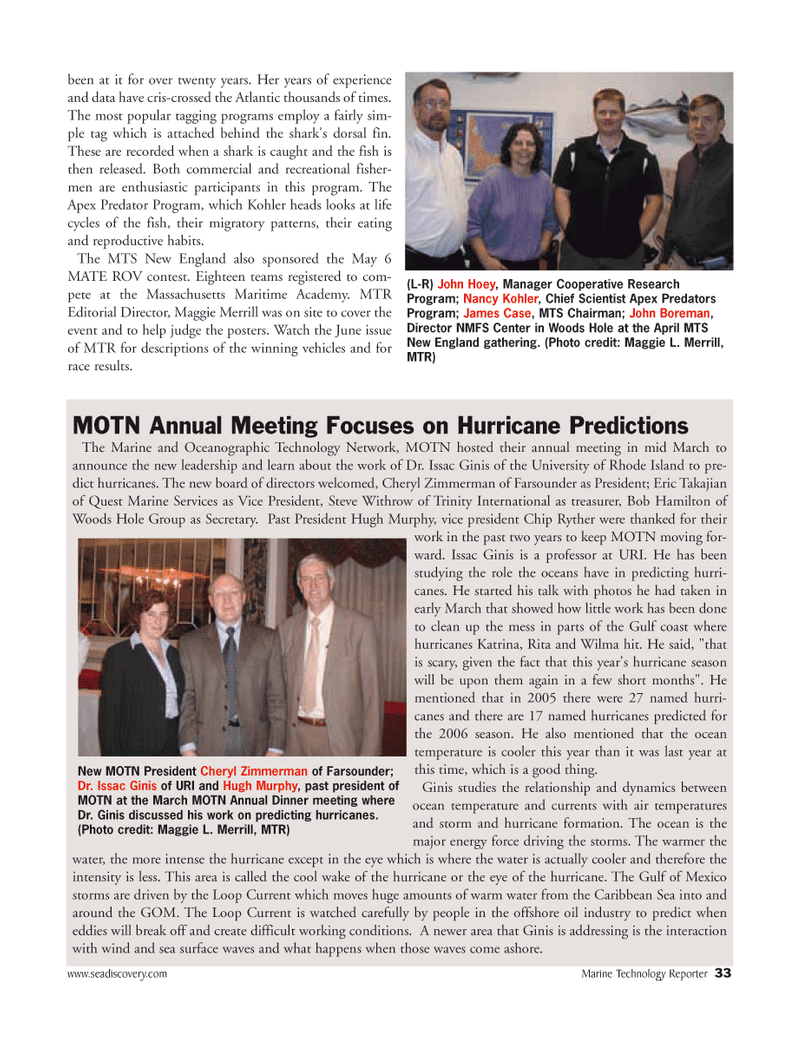
Page 33: of Marine Technology Magazine (May 2006)
The Communications Edition
Read this page in Pdf, Flash or Html5 edition of May 2006 Marine Technology Magazine
www.seadiscovery.com Marine Technology Reporter 33 been at it for over twenty years. Her years of experience and data have cris-crossed the Atlantic thousands of times.
The most popular tagging programs employ a fairly sim- ple tag which is attached behind the shark's dorsal fin.
These are recorded when a shark is caught and the fish is then released. Both commercial and recreational fisher- men are enthusiastic participants in this program. The
Apex Predator Program, which Kohler heads looks at life cycles of the fish, their migratory patterns, their eating and reproductive habits.
The MTS New England also sponsored the May 6
MATE ROV contest. Eighteen teams registered to com- pete at the Massachusetts Maritime Academy. MTR
Editorial Director, Maggie Merrill was on site to cover the event and to help judge the posters. Watch the June issue of MTR for descriptions of the winning vehicles and for race results. (L-R) John Hoey, Manager Cooperative Research
Program; Nancy Kohler, Chief Scientist Apex Predators
Program; James Case, MTS Chairman; John Boreman,
Director NMFS Center in Woods Hole at the April MTS
New England gathering. (Photo credit: Maggie L. Merrill,
MTR)
MOTN Annual Meeting Focuses on Hurricane Predictions
The Marine and Oceanographic Technology Network, MOTN hosted their annual meeting in mid March to announce the new leadership and learn about the work of Dr. Issac Ginis of the University of Rhode Island to pre- dict hurricanes. The new board of directors welcomed, Cheryl Zimmerman of Farsounder as President; Eric Takajian of Quest Marine Services as Vice President, Steve Withrow of Trinity International as treasurer, Bob Hamilton of
Woods Hole Group as Secretary. Past President Hugh Murphy, vice president Chip Ryther were thanked for their work in the past two years to keep MOTN moving for- ward. Issac Ginis is a professor at URI. He has been studying the role the oceans have in predicting hurri- canes. He started his talk with photos he had taken in early March that showed how little work has been done to clean up the mess in parts of the Gulf coast where hurricanes Katrina, Rita and Wilma hit. He said, "that is scary, given the fact that this year's hurricane season will be upon them again in a few short months". He mentioned that in 2005 there were 27 named hurri- canes and there are 17 named hurricanes predicted for the 2006 season. He also mentioned that the ocean temperature is cooler this year than it was last year at this time, which is a good thing.
Ginis studies the relationship and dynamics between ocean temperature and currents with air temperatures and storm and hurricane formation. The ocean is the major energy force driving the storms. The warmer the water, the more intense the hurricane except in the eye which is where the water is actually cooler and therefore the intensity is less. This area is called the cool wake of the hurricane or the eye of the hurricane. The Gulf of Mexico storms are driven by the Loop Current which moves huge amounts of warm water from the Caribbean Sea into and around the GOM. The Loop Current is watched carefully by people in the offshore oil industry to predict when eddies will break off and create difficult working conditions. A newer area that Ginis is addressing is the interaction with wind and sea surface waves and what happens when those waves come ashore.
New MOTN President Cheryl Zimmerman of Farsounder;
Dr. Issac Ginis of URI and Hugh Murphy, past president of
MOTN at the March MOTN Annual Dinner meeting where
Dr. Ginis discussed his work on predicting hurricanes. (Photo credit: Maggie L. Merrill, MTR)
MTR#4 (17-32).qxd 5/8/2006 9:57 AM Page 33

 32
32

 34
34
